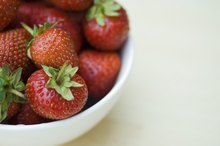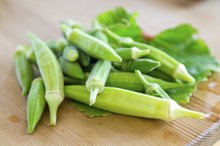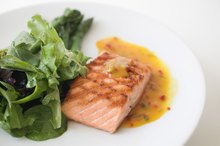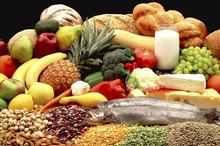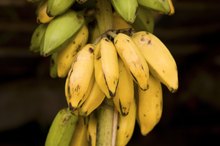Low Potassium and High Fiber Foods
High-potassium, high-fiber foods are better for most people than foods low in potassium, fiber or both. However, some health conditions, such hyperkalemia -- high potassium levels -- require a low potassium diet. Fortunately, there are several foods low in potassium and high in fiber.
Roles of Fiber and Potassium
High-fiber foods lower your blood cholesterol levels, reduce digestive-tract problems such as irritable bowel syndrome and gallstones and reduce your risk of colon cancer, diabetes, diverticulosis, heart disease and rectal cancer, according to "The New Pritikin Program." The potassium in foods helps you keep your blood pressure under control, particularly if you have a diet high in high-sodium foods, according to "Potassium and Health," a Colorado State University report. Potassium also plays a role in your cell metabolism and aids in nerve function.
Intake Recommendations
How Much Potassium Does a Female Need?
Learn More
A small percentage of people have hyperkalemia, a blood potassium level higher than 5.0 milliequivalents per liter of blood that is caused by the kidneys' inability to excrete potassium, according to The Merck Manual. Often, there are no symptoms, and the diagnosis occurs after a blood test or an electrocardiogram. Hyperkalemia causes severe heart problems when blood potassium exceeds 5.5 milliequivalents per liter.
Getting More Fiber
Fiber is in all plant foods, but not in any animal-based products. The U.S. Department of Agriculture's "Fiber Content of Selected Foods" list reports beans and grains have the most fiber. Other high-fiber foods include cereal, bread, pasta, rice, strawberries, several other berries, artichokes, pears, plums, spinach, lettuce and brussels sprouts. Potassium is in plant- and animal-based foods, including potatoes, tomatoes, oranges, bananas, meats and dairy products, according to "An Invitation to Health."
- Fiber is in all plant foods, but not in any animal-based products.
- Potassium is in plant- and animal-based foods, including potatoes, tomatoes, oranges, bananas, meats and dairy products, according to "An Invitation to Health."
Low-Potassium Foods to Choose
Potassium and Coumadin
Learn More
Low-potassium foods have fewer than 100 mg of potassium per serving, according to "Potassium and Health." The U.S. Department of Agriculture's "Potassium Content of Selected Foods" reports dozens of high-fiber foods have less than 0.1 g or 100 mg of potassium, including bread, cereal, pasta, rice, strawberries, pears, plums, spinach, lettuce, mushrooms, pineapple, peppers, plums, cauliflower and radishes.
Intake Recommendations
"An Invitation to Health" reports Americans eat only about 12 g of fiber daily, but the Institute of Medicine recommends that women should eat 25 g of fiber daily. "Potassium and Health" reports most Americans do not eat enough potassium. You should eat 4.7 g of potassium daily, recommends the Institute of Medicine. However, people with hyperkalemia should reduce their potassium intake to 2 g daily and cut their sodium intake because a high-sodium, low-potassium diet can cause hypertension, reports The Merck Manual.
- "An Invitation to Health" reports Americans eat only about 12 g of fiber daily, but the Institute of Medicine recommends that women should eat 25 g of fiber daily. "
- However, people with hyperkalemia should reduce their potassium intake to 2 g daily and cut their sodium intake because a high-sodium, low-potassium diet can cause hypertension, reports The Merck Manual.
Related Articles
References
- The Merck Manual of Medical Information; 2003
- "The New Pritikin Program"; Robert Pritikin; 2007
- "An Invitation to Health"; Dianne Hales; 2003
- U.S. Department of Agriculture: Potassium Content of Selected Foods
- U.S. Department of Agriculture: Fiber Content of Selected Foods
- Linus Pauling Institute: Potassium
- Linus Pauling Institute: Fiber
- Potassium. Office of Dietary Supplements. National Institutes of Health
- Lambert H, Frassetto L, Moore JB, et al. The effect of supplementation with alkaline potassium salts on bone metabolism: a meta-analysis. Osteoporos Int. 2015;26(4):1311-8. doi:+10.1007/s00198-014-3006-9
- Chatterjee R, Slentz C, Davenport CA, et al. Effects of potassium supplements on glucose metabolism in African Americans with prediabetes: a pilot trial. Am J Clin Nutr. 2017;106(6):1431-1438. doi:10.3945/ajcn.117.161570
- Potassium. Fact Sheet for Consumers. Office of Dietary Supplements. National Institutes of Health
- Health Claim Notification for Potassium Containing Foods. US Food and Drug Administration
- Aburto NJ, Hanson S, Gutierrez H, Hooper L, Elliott P, Cappuccio FP. Effect of increased potassium intake on cardiovascular risk factors and disease: systematic review and meta-analyses. BMJ 2013;346:f1378.
- Academy of Nutrition and Dietetics. What Is Potassium?
- ConsumerLab.com. Potassium Supplements Review.
- Curhan GC, Willett WC, Rimm EB, Stampfer MJ. A prospective study of dietary calcium and other nutrients and the risk of symptomatic kidney stones. N Engl J Med 1993;328:833-8.
- Curhan GC, Willett WC, Speizer FE, Spiegelman D, Stampfer MJ. Comparison of dietary calcium with supplemental calcium and other nutrients as factors affecting the risk for kidney stones in women. Ann Intern Med 1997;126:497-504.
- D’Elia L, Barba G, Cappuccio FP, Strazzullo P. Potassium intake, stroke, and cardiovascular disease a meta-analysis of prospective studies. J Am Coll Cardiol 2011;57:1210-9.
- O’Neil C, Keast D, Fulgoni V, and Nicklas T. Food sources of energy and nutrients among adults in the US: NHANES 2003-2006. Nutrients. 2012;4:2097-120. DOI: 10.3390/nu4122097.
- Stone M, Martyn L, and Weaver C. Potassium intake, bioavailability, hypertension, and glucose control. Nutrients. 2016;8: E444. DOI: 10.3390/nu8070444.
- U.S. Food and Drug Administration. Health Claim Notification for Potassium Containing Foods.
- Weaver CM. Potassium and health. Adv Nutr 2013;4:368S-77S.
- Yong Sun, et al. Dietary potassium regulates vascular calcification and arterial stiffness. JCI Insight. 2017;2(19):e94920.
Resources
- "Dr. Dean Ornish's Program for Reversing Heart Disease"; Dr. Dean Ornish; 1996
- The National Academies Press: Mean and Percentiles for Usual Daily Intake of Dietary Fiber
Writer Bio
Jay Schwartz has had articles printed by the "Chicago Tribune," "USA Today" and many other publications since 1983. He's covered health, fitness, nutrition, business, real estate, government, features, sports and more. A Lafayette, Pa. college graduate, he's also written for several Fortune 500 corporate publications and produced business newsletters.



